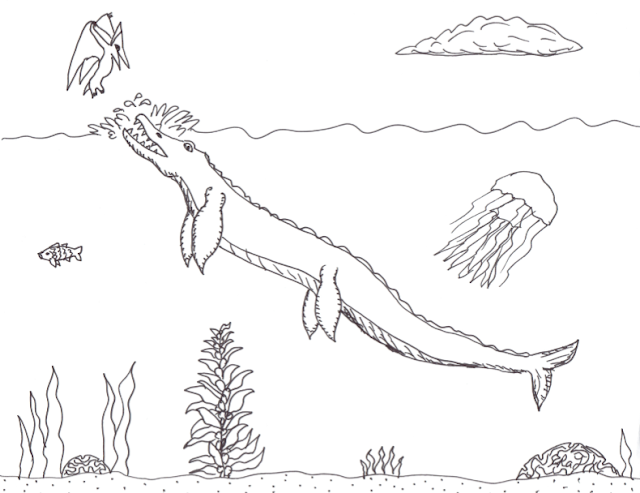This is
a free
coloring
pages
blog.
All
drawings
are
free
to
print.
There
are no
ads and
no fees.
Today's drawing
is of the
Early Jurassic
Ocean or Sea.
This top drawing is of the Early Jurassic ocean or sea. The organisms are all from that time period. So while Allosaurus, Stegosaurus, and Apatosaurus were roaming the land, these animals were roaming the seas.
The animals in the drawing are as follows: There is an Ichthyosaur after a fish called Hypsocormus. Hypsocornus was a three-foot-long or about 1-meter long fish. There is a jawless fish. Jawless fish still exist in the waters of Earth. Jawless fish are of the Class: Agnatha and some attach to other water life and suck their blood. Some Agnatha live in freshwater too. There is a long fish and it is swimming under the Orthocone. It is a bony fish or Class: Osteichthyes. There also two jellyfish. Jellyfish first appeared way BEFORE the Mesozoic Era. The things that look like flowers are sea lilies. But they are not flowers. Sea Lilies are a type of filter feeder that fed on plankton. They are a type of animal and some still exist in our modern oceans. They are also called Crinoids. Crinoids also evolved way before the Mesozoic Era.
This drawing is of life in the oceans in the Early Jurassic... which was about 200 million years ago. The Orthocones were about to go extinct and Ichthyosaurs were fairly new to the ocean and the planet. There are also two Mesozoic plants in the drawing. The Ichthyosaurs were large marine reptiles that lived in much of the Mesozoic Era. Some were as big as 70 feet long. That would be over 21 meters!
By the way, the Orthocones are related to the extinct Ammonites. Some Orthocones were a few inches long and some were 20 feet or over 6 meters long. In some periods of the Paleozoic Era, the large Orthocones were the apex predator or the top predator. Orthocones were in Class: Cephalopoda... so they were early cephalopods. Their modern relatives are squid, octopus, cuttlefish, and the nautilus.
To be clear, the dinosaurs and great Marine Reptiles lived in the Mesozoic Era. The Mesozoic Era is divided into three periods: The first is the Triassic Period. Then there was the Jurassic Period. And the last period of the Mesozoic Era was the Cretaceous Period.
NOTE: I will also post some other drawings of ancient ocean animals. I will post them (or I should say re-post them) below. To get to the printable pages just click on the button labeled "Paleontology." Then scroll down to the bottom of the list for the new drawing. The older drawings will be further up the list.
Anomalocaris First Super Predator
(This is the Cambrian Ocean. The Cambrian Period was the first period of the Paleozoic Era. The Paleozoic Era was before the Mesozoic Era.)
Pliosaur Rhomaleosaurus
(Rhomaleosaurus was also an Early Jurassic animal. This was around the time that Ammonites appeared as well. The curly animals that looks like a curly Orthocone is an Ammonite. Pliosaurs were short-necked Plesiosaurs.)
Plesiosaurus surfacing
(This is a long neck Plesiosaur. They lived in both the Jurassic and into the late-Cretaceous Periods.)
Elasmosaurus mother and calf
(Elasmosaurus was a late-Cretaceous long-necked Plesiosaur. and yes there were sharks back then.)
Mosasaur after a Pteranodon
(Mosasaurs were to top predator of the late-Cretaceous.)
Shonisaurus feeding
(This was the 70 feet long Ichthyosaur from the Triassic Period. Oddly enough it was found in the desert of Southern Nevada hundreds of miles from the nearest ocean. You can go see the 6 or 7 individuals of this species... or their bones anyway... at Berlin-Ichthyosaur Historic State Park.)
Tylosaurus with Ammonites
(Tylosaurus was one of or possibly the largest Mosasaur.)
Tylosaurus with Large Scales
Ichthyosaur anningae hunting an Ammonite
(This Ichthyosaur was named after the great paleontologist: Mary Anning. She found many of the Ichthyosaur and Plesiosaur fossils that introduced the world to Marine Reptiles. She also found the first Pterosaur that had ever been found outside of Germany.)
Mary Anning and 3 species she discovered











No comments:
Post a Comment